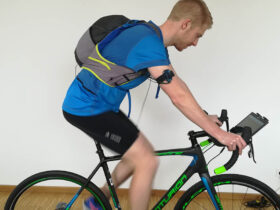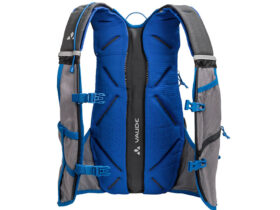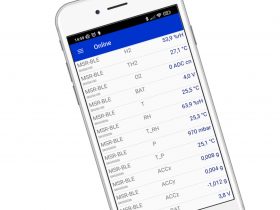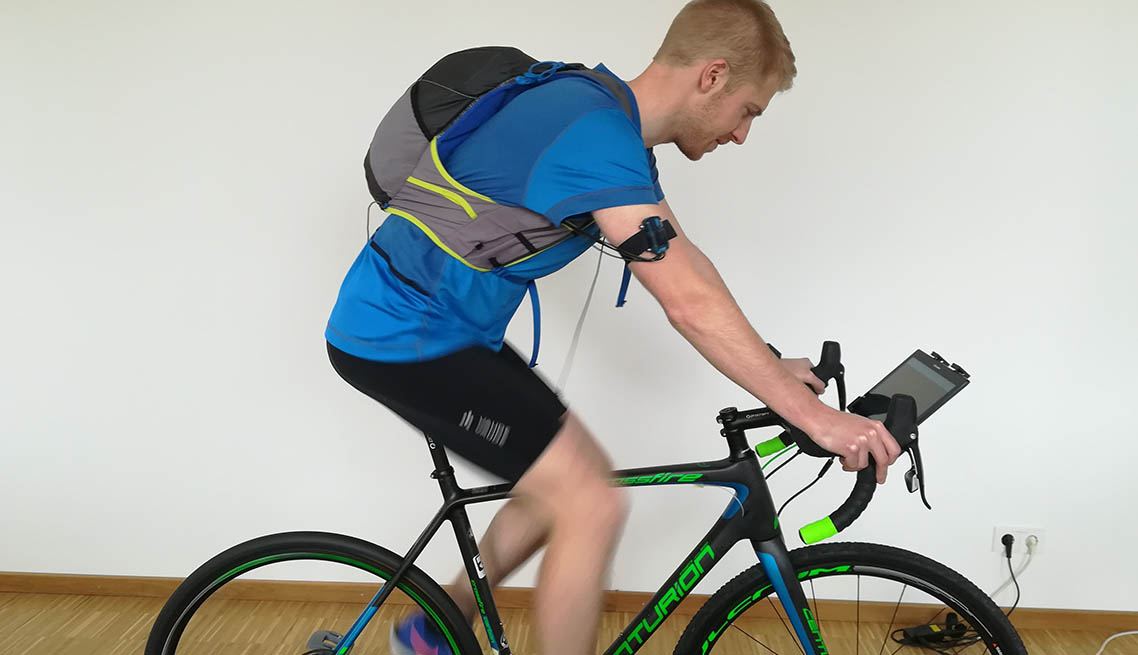
Thermophysiological Comfort of Bicycle Backpacks
Wireless data logger MSR147WD case study
Wearing a backpack during sporting activities influences not only the wearer’s subjective feeling of comfort but also thermoregulation, as it behaves in a similar way to an item of clothing. Using miniature data loggers by the MSR Electronics GmbH, moisture and temperature measurements were taken between body and backpack. This allows the material and design properties of the backpacks to be optimised.
Authors: Markus Weder, MSR Electronics GmbH, Seuzach, Switzerland, Robert Klauer and Frank I. Michel, VAUDE Sport GmbH & Co. KG, i-team, Tettnang, Germany, Franziska Breuner and Stephan Odenwald, TU Chemnitz, Sports Equipment & Technology, Germany
Even though a backpack covers only part of your body, wearing a backpack when doing sports or activities that make you sweat has a significant impact on the thermoregulation. The overall feeling of comfort is often affected in a negative way by extreme perceptions of local temperature or moisture. For example, a damp back as a result of wearing a backpack can result in a thermophysiological feeling of discomfort, even though the clothing as such would be ideal and there is no increase in the core temperature.
Method of measurement
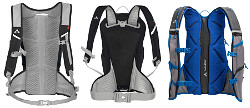 During a complex series of tests on test subjects at VAUDE, three different types of backpacks (U, A and T, fig. 1) with different designs were examined while being worn by four test subjects on a bicycle ergometer in a climatic chamber (fig. 2). Wireless data loggers of the type MSR147WD by MSR Electronics GmbH were used to measure temperature and relative humidity, both in the microclimate on the body and on the backpack (on the contact surface with the back). In order to better quantify the measured data obtained, the same measurements were also taken without a backpack.
During a complex series of tests on test subjects at VAUDE, three different types of backpacks (U, A and T, fig. 1) with different designs were examined while being worn by four test subjects on a bicycle ergometer in a climatic chamber (fig. 2). Wireless data loggers of the type MSR147WD by MSR Electronics GmbH were used to measure temperature and relative humidity, both in the microclimate on the body and on the backpack (on the contact surface with the back). In order to better quantify the measured data obtained, the same measurements were also taken without a backpack.
Bluetooth data logger MSR147WD
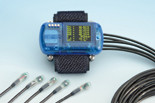 The MSR147WD wireless data logger used in the study has been designed by MSR Electronics GmbH specifically for measuring the physiological properties of textiles. The logger, which is equipped with Bluetooth Low Energy (BLE) short-range wireless technology and a memory that is capable of storing 1 million measured values, is merely the size of a thumb; it accurately records physiological parameters such as skin temperature and moisture level by means of five plug-in humidity and temperature sensors. Figure 3 shows the positions of the temperature and humidity sensors on the back of the test subject
The MSR147WD wireless data logger used in the study has been designed by MSR Electronics GmbH specifically for measuring the physiological properties of textiles. The logger, which is equipped with Bluetooth Low Energy (BLE) short-range wireless technology and a memory that is capable of storing 1 million measured values, is merely the size of a thumb; it accurately records physiological parameters such as skin temperature and moisture level by means of five plug-in humidity and temperature sensors. Figure 3 shows the positions of the temperature and humidity sensors on the back of the test subject
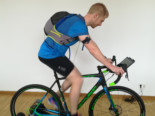 Due to the automatic configuration feature, the data logger recognises when a sensor is inserted. The calibration data is stored in the relevant sensor. You can retrieve the measured values online at any time by means of BLE or the USB port.
Due to the automatic configuration feature, the data logger recognises when a sensor is inserted. The calibration data is stored in the relevant sensor. You can retrieve the measured values online at any time by means of BLE or the USB port.
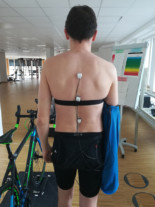 When testing functional clothing by measuring comfort on the skin and in the microclimate between the individual layers of clothing, the Bluetooth Low Energy wireless technology makes the work significantly easier. With the help of the wireless transmission of the measured data, the current measured values can be read out at any time with the MSR smartphone app. It can also be used to check whether the data is being properly recorded, without the test subject having to waste time to put on and take off the clothing. Thanks to the integrated OLED screen in the data logger, the current measured data can be checked even while measuring takes place, without having to use a mobile phone. With the “MSR DataLogger” app, you can start, stop, read out and send data recordings to the MSR SmartCloud from your mobile phone. MSR SmartCloud facilitates the storage of measured data on a server via the Internet, allowing the user to view the measured data of the data logger wherever they are and to grant further participants access to his/her measured data, if required.
When testing functional clothing by measuring comfort on the skin and in the microclimate between the individual layers of clothing, the Bluetooth Low Energy wireless technology makes the work significantly easier. With the help of the wireless transmission of the measured data, the current measured values can be read out at any time with the MSR smartphone app. It can also be used to check whether the data is being properly recorded, without the test subject having to waste time to put on and take off the clothing. Thanks to the integrated OLED screen in the data logger, the current measured data can be checked even while measuring takes place, without having to use a mobile phone. With the “MSR DataLogger” app, you can start, stop, read out and send data recordings to the MSR SmartCloud from your mobile phone. MSR SmartCloud facilitates the storage of measured data on a server via the Internet, allowing the user to view the measured data of the data logger wherever they are and to grant further participants access to his/her measured data, if required.
Measurement results
All of the tested types of backpacks have special design features that are intended for their desired area of application. Depending on the application, a tight-fitting backpack or a backpack with an airflow spacer and appropriate ventilation is ideal. Thanks to the measurement data, it was possible to observe that the three types of backpacks showed different measurement results. The closer the temperature and relative humidity come to the optimum zero value (series of measurements without backpack), the more comfortable the backpack is to the wearer.
observe that the three types of backpacks showed different measurement results. The closer the temperature and relative humidity come to the optimum zero value (series of measurements without backpack), the more comfortable the backpack is to the wearer.
In terms of temperature, backpack A is the one with the lowest temperature increase, both in the microclimate and on the backpack; followed by backpacks T and U (Fig. 4).
With regard to relative humidity (Fig. 5), the two backpacks U and T are slightly more advantageous compared to backpack A (approx. 5 to 10 % lower). This was measured both in the microclimate and on the backpack. However, sample U has a significantly higher backpack moisture content than the other two samples. A higher humidity on the backpack can mean that the humidity has moved away from the microclimate into the backpack, or that the humidity evaporates too slowly from the backpack into the ambient air. In principle, a high backpack moisture content and a lower microclimate moisture content are advantageous. The sensors of the human skin do not register any humidity because humans do not possess any humidity sensors per se, but only temperature sensors (in addition to pressure and pain sensors). Humidity, however, changes the sensory perception of the skin, e.g. when underwear sticks to the skin.
The differences in temperature at the end of the stress phase are relatively large, both in the microclimate and on the backpack, measuring 3° to 4°C. Humans can perceive differences in temperature of as little as 1°C. Accordingly, the thermoregulation of a backpack, resulting in a lower increase in temperature on the back (compared to the blank value), is more beneficial. This leads to an increase in the evaporative cooling, therefore an improved heat dissipation and, accordingly, also a better performance.
Backpack T comes closest to the optimum zero value (measurement without backpack) and has the most favourable humidity values of the three backpack samples, in both the microclimate and the backpack. Backpack U still exhibits a slightly lower humidity in the microclimate, but the relative humidity in the backpack is significantly higher, even slightly higher than in backpack A, where the highest microclimate humidity was measured.
Summary
Depending on the application, a better performance may be preferable to a less damp back. Where and in which stress phases, and during which temperature and weather conditions the backpack is used plays an important role in this.
Based on these measurements, the different design features and materials of the individual layers of VAUDE can be better optimised with respect to the desired requirements. The wearer therefore obtains the best possible backpack for his/her planned activity.
 Deutsch
Deutsch

